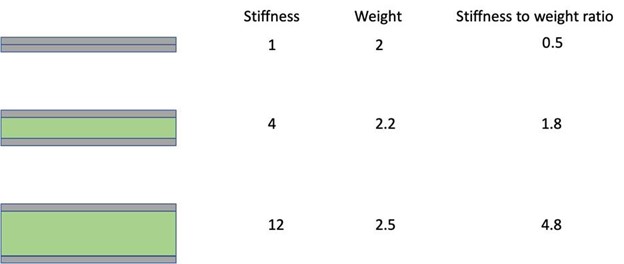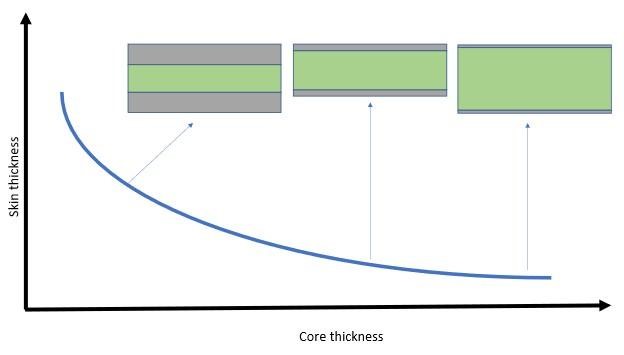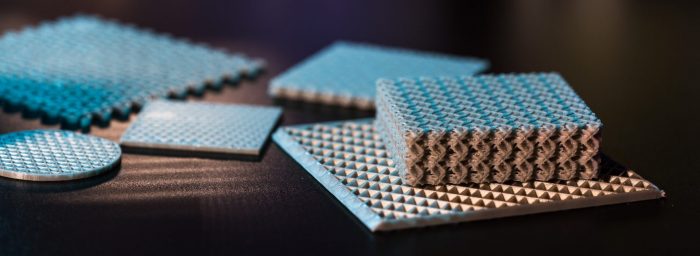How do sandwich panels work?
A sandwich panel works by inserting a lightweight core material between two thin, stiff facesheets. If the whole sandwich panel deforms it behaves as a composite material that is stronger than the sum of its parts.
The composite parts work together by having the thin (yet stiff) faces resist bending, while the thick (yet compliant) core absorbs any deformation from shearing or sliding. But the stiffness and strength of the panel depends not only on the stiffness of the faces, but also the thickness of the core. When the stiff skins are bonded to a core, it keeps the skins separated from each other, massively increasing the overall bending stiffness of the sandwich panel structure without appreciably increasing the weight.
Core and skin materials
The core should be lightweight and the skins should be stiff. Ideally, core and skins should be able to be bonded together easily. Often a foam or honeycomb material made of thermoplastic polymer is used as the lightweight core, and stiffer products like steel and fiber-reinforced materials are used for the skins.
The importance of stiffness-to-weight in a sandwich panel
A sandwich panel makes efficient use of material by placing stiff components where they are needed most – in this case, on either side of the core – and lessening weight everywhere else.
To visualize this efficiency, imagine making a series of sandwich panels with aluminum skins and a lightweight foam core., The skins are always the same thickness, but we’ll adjust the core by cutting our foam to different thicknesses.
If there is no foam at all, then we can see the stiffness for the two skins is at 1 (see Figure 1 below). By adding foam between, both the weight and stiffness increase, but crucially, the stiffness-to-weight ratio increases dramatically as the panel gets thicker.

How to choose the right materials for sandwich panel cores and skins
This question can be hard to answer, since it depends on your application. So let’s use a concrete example.
For semi-trailer transportation, weight is king – but the walls of a dry van still need to be stiff enough to bear the load it carries and potentially hold up to curveballs like strong winds, falling cargo, or errant forklifts.
We’ll need to choose a sandwich panel with the right stiffness for the job, and it turns out that there are many different skin and core thickness options that all give the same stiffness (Figure 2).
To get the best panel for our semi-trailer, we need to optimize the combination of skins and core that gives the lightest sandwich without sacrificing stiffness. If multiple types of material can be considered for both skins and core, then our problem becomes even more involved, but still tractable.

Building an optimal sandwich panel sounds easy enough. What’s the catch?
Sandwich panels rely on continued bonding between the skins and core to remain effective. Often the compliant core material is the weak point, and will fracture long before the adhesive bond or the skins fail. One problem with using lightweight foams is that they are relatively weak, so sometimes honeycomb cores are used instead to get a boost in strength. Unfortunately, honeycomb also suffers drawbacks as it is more difficult to bond to the skins and, when deformed, it has a natural tendency to peel away from the skins in a process called delamination.
Armory Technologies’ sandwich panel solutions
To mitigate these inherent bonding problems, Armory Technologies uses MetaCORE®, a hybrid core material that combines the lightweight properties of foam or honeycomb with high shear strength. What makes MetaCORE® unique is that it’s a mechanical metamaterial. Its complex geometric structure imbues the core material with characteristics not found in other sandwich panels.
As you can see, it isn’t always easy to determine what the right size and shape of a panel should be, and it varies from application to application. Regardless of size, Armory Technologies panels for semi-trailers are optimized to reduce weight without sacrificing strength.
Sandwich panels for semi-trailers
ArmorONE is Armory Technologies superior sandwich panel for semi-trailers, offering substantial weight reduction with exceptional strength.
View ArmorONE





